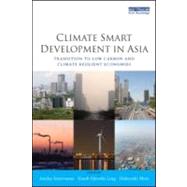- ISBN: 9781844078622 | 1844078620
- Cover: Paperback
- Copyright: 3/22/2012
The future of China, India and Asia's other emerging economies and their ability to take a 'low-carbon' and 'climate-resilient' development path will determine the future of global carbon emissions and climate change. Indeed, the battle to confront global climate change will be won or lost in Asia. The transition to a low-carbon, climate-resilient economy (LCE), which involves many steps towards improved energy efficiency, alternative energy sources and transport systems, sustainable land use, eco-friendly consumption and proactive adaptation, may be regarded as the world's fourth revolution, after the industrial revolution, agricultural revolution, and the information revolution. Asia is highly vulnerable to impacts of climate change. Yet because of its dynamic economies and massive populations, Asia offers the greatest opportunity for overcoming the trade-offs and pursuing low-carbon development pathways. With a growing consensus that there is limited time to avoid the worst impacts of climate change, scientists, engineers, policymakers, and economists across Asia have recently begun discussions on how Asia can make a transition to LCE. Most discussions, however, focused on transfer of technologies from developed to developing countries and overlooked other equally important challenges such as financing, governance, and information dissemination. This book is the first to look at these neglected aspects of LCE and attempt to integrate both market-based and technology-based solutions into a comprehensive strategy to creating a roadmap for LCE in Asia. The introductory section defines LCE and examines both conceptual and practical issues that will need to be addressed to realize LCE in Asia. The second section presents case studies from China, India, Japan and Taiwan to illustrate the potential and challenges for transitioning to a LCE. The third section focuses on key enabling conditions, such as technology, financing and governance including information dissemination, which are crucial to make further progress in transforming Asian societies. Themes and sectors addressed range from transport and power generation to finance and urban governance to the potential for carbon capture and storage. A final section looks at the different pathways available in Asia for making a rapid transition towards LCE, where further research is needed and what mechanisms can lead to the revolutionary changes in the current energy structures, economic development models and human behaviour necessary to achieve objectives that impact billions of people and the global climate. This book is essential reading for economists, policy makers and governments, engineers and researchers concerned with climate change, energy production and development in Asia and the impacts and potential for the world.







